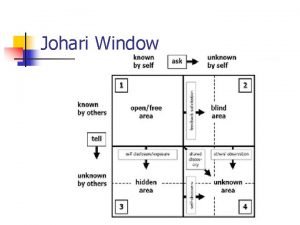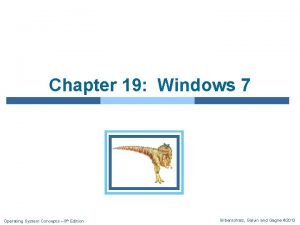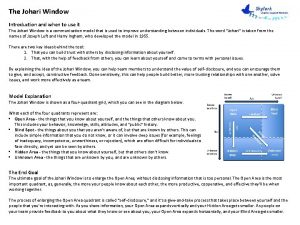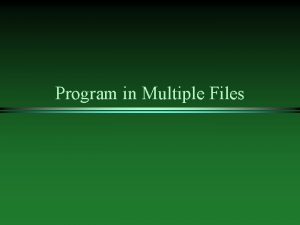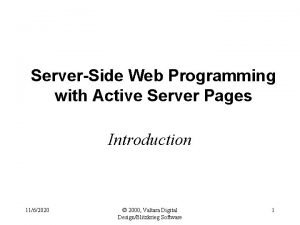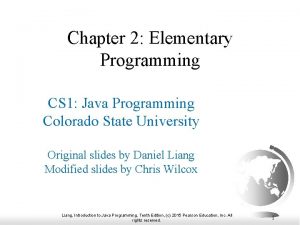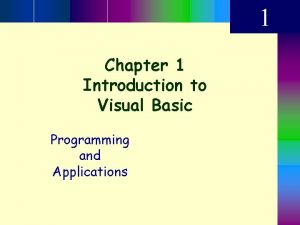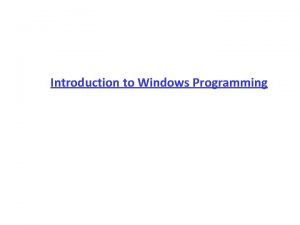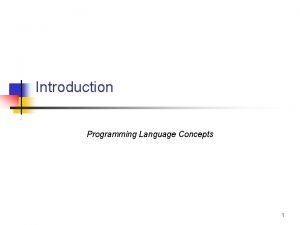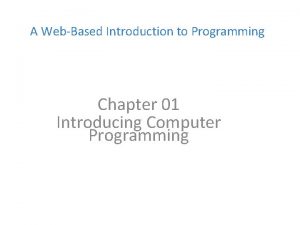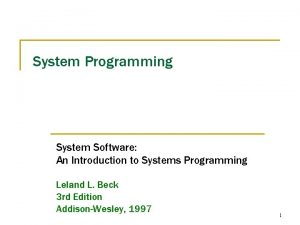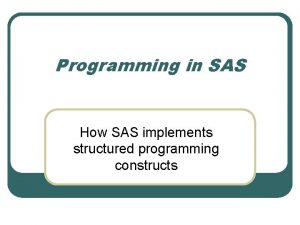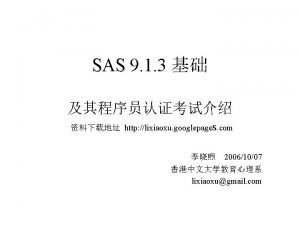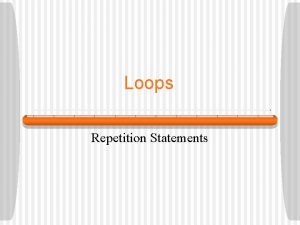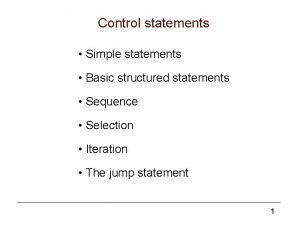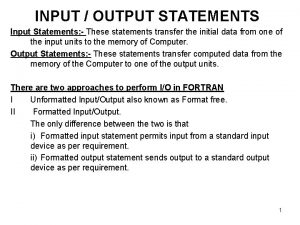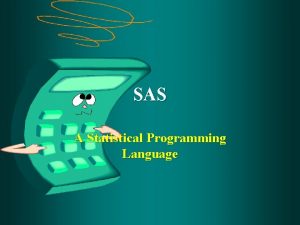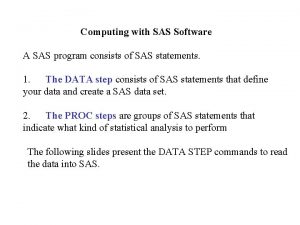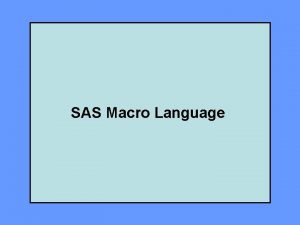SAS Programming Introduction Program Window SAS Statements Go











































- Slides: 43

SAS Programming: Introduction


Program Window: SAS Statements Go Here

SAS Log: Results of Program Execution

Run Button: Executes all SAS statements in Program editor

Other Toolbar Functions

Drop-Down Menus

SAS Programs • Composed of SAS Statements • All SAS Statements end with a Semicolon • EXCEPT Data lines • Example SAS Statement: input name $ sex $ age height; • Comment lines are preceded by *

SAS Variable Names • 1 -8 characters • Must begin with a letter

Composition of SAS Programs • Beginning: Create a SAS data set • Middle: Work with data using SAS procedures (PROCs) • End: RUN the program

SAS and Data: SAS Data Sets • SAS is flexible. Can read data from many sources • Sometimes you can get SAS data sets from data sources (BLS, etc. ) • First step is to convert raw data to a SAS data set

A SAS Program: Beginning *BEGINNING: Create a SAS data set containing data. * Step 1: 2 steps. ; Create a SAS data set; data htwt; input name $ sex $ age height weight; x = height + weight; y = age**2; z = 3*age - 5; * * * create data set named HTWT ; input variables by name and type; create x ; create y - ** exponentiation ; create z - * multiplication ; SAS Statements: data, input, x =, y =, z =

Beginning: Data Step Processing *BEGINNING: Create a SAS data set containing data. * Step 1: 2 steps. ; Create a SAS data set; data htwt; input name $ sex $ age height weight; x = height + weight; y = age**2; z = 3*age - 5; * * * create data set named HTWT ; input variables by name and type; create x ; create y - ** exponentiation ; create z - * multiplication ; data: Tells SAS the name of the SAS data set being created.

Beginning *BEGINNING: Create a SAS data set containing data. * Step 1: 2 steps. ; Create a SAS data set; data htwt; input name $ sex $ age height weight; x = height + weight; y = age**2; z = 3*age - 5; * * * create data set named HTWT ; input variables by name and type; create x ; create y - ** exponentiation ; create z - * multiplication ; input: Tells SAS the names of the variables being read. varname $ means character data.

Beginning * Step 2: Input observations ; * the cards statement precedes data. The data lines; * DO NOT have semi-colons ; *input name $ sex $ age height weight; cards; alfred alice barbara henry john sally ; M F F M M F 14 13 14 15 16 16 69 56 62 67 70 63 112 84 102 135 165 120 cards: Tells SAS the following lines are data. Data must follow

Delimiters • Must separate variables on cards or external files • Accomplished with “delimiters” • Spaces are common, SAS default • Can also use other characters, but must tell SAS

Middle: Work with data *MIDDLE: Work with the data. * Step 3: 1 Step. ; Operate with the SAS data; proc print; * print the data; title 'Height-Weight Example #1'; * put title with data; proc: A SAS procedure. These are how you work with the data in SAS. There are many SAS procedures. print: SAS procedure to create an output file. By default, uses the data from the last data statement.

Summary Statistics in SAS • Means and Standard Deviations can be easily calculated for variables in a SAS data set using the means procedure • Format: proc means; var v 1 v 2 v 3; • List all the variables you want summary statistics for on the second line

Output from proc means Summary Statistics 07: 22 Thursday, October 28, 1999 3 Variable N Mean Std Dev Minimum Maximum --------------------------------X 6 184. 1666667 32. 4679329 140. 0000000 235. 0000000 Y 6 216. 3333333 35. 4664160 169. 0000000 256. 0000000 Z 6 39. 0000000 3. 6331804 34. 0000000 43. 0000000 --------------------------------

End: Run program *END: Run the program. * Step 4: run; 1 step; Run the program; *Run the above statements;

data htwt; input name $ sex $ age height weight; x = height + weight; y = age**2; z = 3*age - 5; cards; alfred alice barbara henry john sally ; M F F M M F 14 13 14 15 16 16 69 56 62 67 70 63 112 84 102 135 165 120 proc means; var x y z; title 'Summary Statistics'; proc print; title 'Height-Weight Example #1'; run;

Errors in SAS Programs • You will make them • Common ones: – Leaving off a semi-colon from the end of a SAS statement – Misspelling – Omitting one quote (‘) in infile or title statement • SAS Log will help you to find errors

Some Definitions • Field: Smallest unit of data. One observation of a variable. Can be either character (letters and numbers) or numeric (numbers only). • Record: A single line of input. Contains one or more fields • File: A collection of records

A Character Field *input name $ sex $ age height weight; alfred alice barbara henry john sally ; M F F M M F 14 13 14 15 16 16 69 56 62 67 70 63 112 84 102 135 165 120

A Numeric Field *input name $ sex $ age height weight; alfred alice barbara henry john sally ; M F F M M F 14 13 14 15 16 16 69 56 62 67 70 63 112 84 102 135 165 120

A Record *input name $ sex $ age height weight; alfred alice barbara henry john sally ; M F F M M F 14 13 14 15 16 16 69 56 62 67 70 63 112 84 102 135 165 120

A File *input name $ sex $ age height weight; alfred alice barbara henry john sally ; M F F M M F 14 13 14 15 16 16 69 56 62 67 70 63 112 84 102 135 165 120

Reading External Files data capm; infile 'a: TABLE. TXT'; input x 1 x 2 m; * create the dataset capm; * open the data file Table. txt; * input the variables; proc print; var x 1 x 2 m; title 'CAPM Data'; * print; * variables; * print title; run; * run;

Input Styles: List Input input x 1 x 2 m; * input the variables; This statement reads in the data in a SAS program. When only the variables are listed, with $ to indicate character variables, it’s called “List Input”, the simplest input style in SAS. You will use different input styles, depending on what the data look like.

Rules for List Input • Fields must be separated by at least 1 blank • Each field must appear in order • Missing values must be represented by a placeholder ( a period. in this case) • No embedded blanks in character fields • Maximum length of character fields is 8 characters • Data must be in a standard format (e. g. text file)

Looking at Data in SAS After creating a SAS data set, it’s a good idea to look at the data to make sure it was read correctly. You can use proc print to write the data to the output window, or you browse the data interactively. Let’s browse the data interactively.




Use control-end or scroll bar

Put cursor on line, type “bl” Press “Enter” key


Close two windows to return to Program Editor

SAS Libraries • Notice that the SAS data file CAPM has another descriptor when we used the “Data Access” menu to browse the data


SAS Libraries • Notice that the SAS data file CAPM has another descriptor when we used the “Data Access” menu to browse the data • The first column is headed “Libname” – Means “SAS Library Name” – CAPM is in Libname “WORK” • SAS organizes data into “Libraries”, which are subdirectories

SAS Libraries • CAPM is in Library “WORK” • SAS automatically creates a Library called WORK in temporary memory. • Anything in WORK is erased when you end your SAS session • SAS data sets can be identified by a two -part name: libname. filename work. capm is equivalent to capm

SAS Libraries • Permanent SAS data files are kept in libraries. To permanently save a SAS data set, you must define a library other than WORK using a LIBNAME statement • Format: LIBNAME libref ‘your-data-library’; • libref is the SAS name for your library • ‘your-data-library’ is a subdirectory
 Paraan ng pagsulat ng katawan
Paraan ng pagsulat ng katawan Manipulation
Manipulation Humanmetrics myers briggs
Humanmetrics myers briggs Windows vista
Windows vista Window to window chapter 28
Window to window chapter 28 Epitympanic recess
Epitympanic recess Impedance matching ear
Impedance matching ear Window to window chapter 19
Window to window chapter 19 Sas tutors
Sas tutors Sas institute v world programming
Sas institute v world programming Sas online tutor for base programming
Sas online tutor for base programming Sas base programming course
Sas base programming course Sas programming tutors
Sas programming tutors Sas programming tutors
Sas programming tutors Perbedaan linear programming dan integer programming
Perbedaan linear programming dan integer programming Greedy programming vs dynamic programming
Greedy programming vs dynamic programming Components of system programming
Components of system programming Integer programming vs linear programming
Integer programming vs linear programming Definisi integer
Definisi integer Window introduction
Window introduction Konsep jendela johari
Konsep jendela johari Non executable statement in program
Non executable statement in program Sas core requirements
Sas core requirements Introduction to server side programming
Introduction to server side programming Problem solving
Problem solving Introduction to programming languages
Introduction to programming languages Daniel liang introduction to java programming
Daniel liang introduction to java programming An introduction to parallel programming peter pacheco
An introduction to parallel programming peter pacheco Intro to visual basic
Intro to visual basic Plc stand for
Plc stand for Programming and problem solving with java
Programming and problem solving with java Introduction to windows programming
Introduction to windows programming Introduction to programming
Introduction to programming Cpe102/csc102 introduction to programming
Cpe102/csc102 introduction to programming A web based introduction to programming
A web based introduction to programming Sic/xe programming examples
Sic/xe programming examples Computer programming chapter 1
Computer programming chapter 1 C programming lectures
C programming lectures Introduction to visual basic
Introduction to visual basic Scratch programming concepts
Scratch programming concepts Python programming an introduction to computer science
Python programming an introduction to computer science Java introduction to problem solving and programming
Java introduction to problem solving and programming Computer programming chapter 1
Computer programming chapter 1 Introduction to java programming 10th edition quizzes
Introduction to java programming 10th edition quizzes


